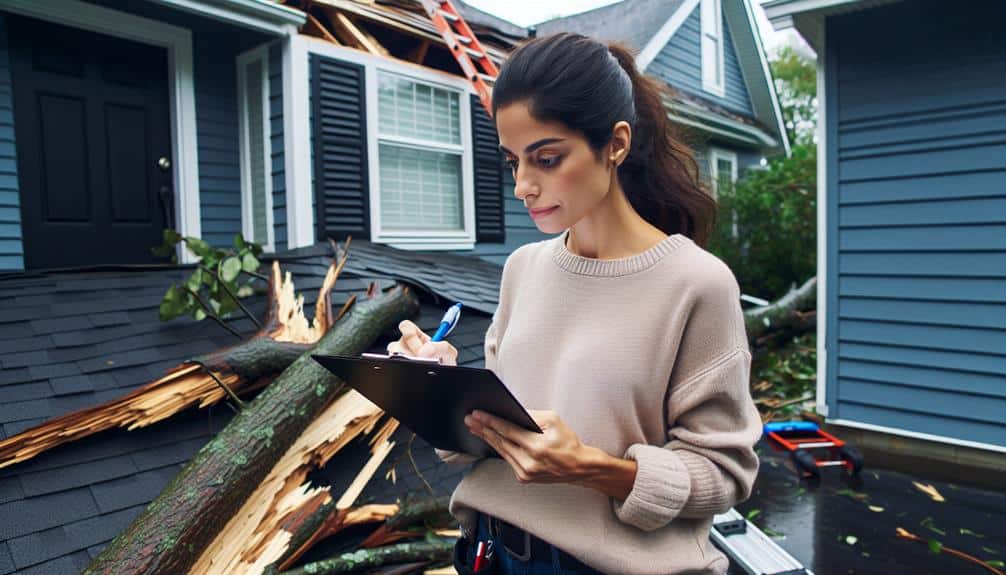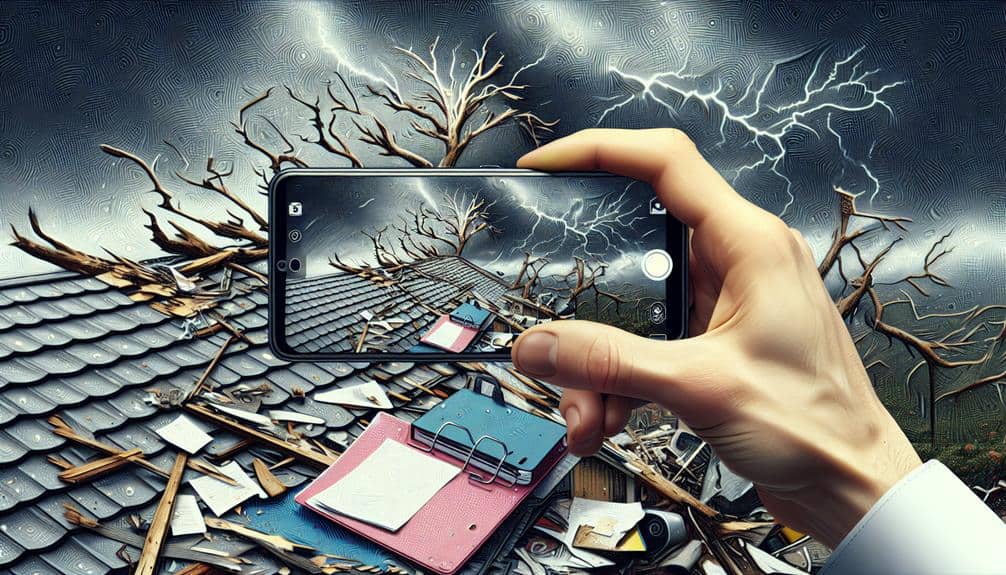When documenting storm damage for a roof replacement, we need to start with a thorough examination, inspecting shingles, granules, and flashing from the ground and rooftop. Capture high-definition photos, both close-ups and wide angles, guaranteeing clear timestamps. Detailed notes on the damage, including weather conditions, should be recorded meticulously. Gathering witness statements and expert opinions strengthens our claim. We must review our insurance policy, submit detailed documentation, and follow up diligently. Consulting a certified inspector for a detailed report and using advanced detection tools guarantees nothing is missed. For more on achieving a successful claim, keep exploring our tips.
Key Points
- Capture high-resolution photos of damage, including close-ups and wide-angle shots, with proper lighting and timestamps.
- Document the type, extent, and location of damage meticulously, including notes on weather conditions during the storm.
- Collect witness statements and expert opinions to support your findings and strengthen your case.
- Review your insurance policy thoroughly to understand coverage details, exclusions, and deductible amounts before filing a claim.
Assess the Damage
First, we'll need to conduct a detailed inspection to accurately assess the extent of the storm damage to the roof. We'll start by examining all visible areas from the ground using binoculars. This allows us to identify any immediate issues like missing shingles, visible punctures, or sagging areas.
Next, we'll need to safely access the roof itself. This step is vital for a thorough damage assessment, as many issues aren't visible from ground level. Once on the roof, we'll check for granule loss on asphalt shingles, which often appears as bald spots and indicates potential water infiltration. We'll also look for cracked, curled, or lifted shingles, as these can compromise the roof's integrity.
Additionally, inspecting the flashing around chimneys, vents, and skylights is crucial to verify these areas haven't been compromised by the storm. We'll also assess the roof's structural elements by looking for any signs of damage to the underlayment and decking. Water stains, mold, or soft spots suggest underlying issues that need immediate attention.
Take Clear Photos
To efficiently document storm damage, we'll need to take clear photos. We should capture close-ups of the damage, show the overall roof condition, and cover each photo includes the date and time.
This thorough approach will provide a detailed record for insurance claims and contractors.
Capture Damage Close-ups
For accurate documentation of storm damage, capturing clear, close-up photos of the affected areas on the roof is essential. When we inspect shingles, we need to focus on any signs of cracking, curling, or missing pieces. These close-ups will provide undeniable evidence of the damage. High-resolution images should be taken to guarantee that every detail is visible. Using a camera with a zoom feature can help us capture those important shots without risking our safety.
Identifying leaks is another vital aspect of documenting storm damage. We should take photos of any water stains, mold, or wet insulation in the attic, as these can indicate where the roof has been compromised. Close-up images of these areas will be invaluable when we present our case to insurance adjusters or contractors.
To maximize the effectiveness of our documentation, we should make sure proper lighting is available. Overcast days provide the best conditions for capturing details without harsh shadows. Additionally, using a flashlight for darker areas can help highlight hidden damage.
Let's remember to keep our photos organized and labeled, making it easier to reference specific areas of concern later on. By following these steps, we can guarantee a thorough and convincing documentation process.
Show Overall Roof Condition
After capturing detailed close-ups, we should step back to take clear, wide-angle photos that showcase the overall condition of the roof. These expansive shots are crucial for a thorough roof inspection and provide a holistic view that can highlight areas of concern that might be overlooked in close-ups.
By documenting the entire roof, we create a detailed record that supports our maintenance efforts and helps when discussing potential replacements with contractors or insurance adjusters.
Here are some key points to keep in mind when photographing the overall roof condition:
- Positioning: Stand at different angles to capture the roof from various perspectives. This ensures that no part of the roof is missed.
- Lighting: Take photos under sufficient lighting conditions to avoid shadows and guarantee clarity.
- Obstructions: Remove any debris or objects that might block the view of the roof.
- Context: Include parts of the surrounding environment in the frame to provide perspective and scale.
Applying these tips during our roof inspection will enhance the effectiveness of our documentation, making sure we're well-equipped for any necessary maintenance or replacements.
Include Date and Time
Incorporating the date and time into our photos ensures we've an exact and chronological record of the roof's condition. This practice is vital for precise damage evaluation and streamlining insurance coverage. When we capture images marked with the date and time, it removes ambiguity and confirms our documentation is undeniable.
This thorough approach aids both in immediate inspection scheduling and in long-term claim preparation. We should utilize devices that automatically timestamp photos, or manually add date and time stamps using photo editing software. Such accuracy is invaluable when presenting evidence to insurance adjusters. It demonstrates our proactive stance and attention to detail, which can significantly affect the approval of our claim.
Moreover, incorporating date and time stamps helps to establish a timeline of events, which is crucial in cases where there might be delays in inspection scheduling. This allows us to substantiate the sequence of damage and repairs over time, providing a detailed narrative that supports our claim.
Record Detailed Notes

We should meticulously document every aspect of the storm damage, noting down specifics such as the location, extent, and type of damage observed. Conducting a thorough roof inspection allows us to gather precise details, ensuring nothing is overlooked. The more detailed our notes, the stronger our case for a roof replacement will be.
During evidence collection, capturing every nuance of the damage is crucial. This includes identifying problem areas and describing the condition of the roofing materials. We need to be as specific as possible to provide a clear, accurate representation of the damage.
Here are key points to include in our notes:
- Location: Note the exact areas on the roof where damage is visible.
- Extent: Describe the severity of the damage, whether it's minor or extensive.
- Type: Specify the kind of damage, such as missing shingles, leaks, or structural damage.
- Materials: Detail the condition of the roofing materials and any affected components.
Gather Witness Statements
Collecting witness statements is essential to corroborate our findings and provide additional perspectives on the storm's impact on the roof. By gathering firsthand accounts, we can build a thorough case that accurately reflects the extent of the damage.
One effective method is to interview neighbors. These individuals likely experienced the same storm and can offer valuable insights into the severity and specific effects they observed. When interviewing, ask detailed questions about what they saw, heard, and felt during the storm. Document their responses meticulously, including dates, times, and specific observations.
Additionally, we should seek expert opinions. Connecting with local meteorologists or structural engineers can provide technical validation of the storm's impact. These professionals can offer a scientifically-backed assessment that strengthens our documentation. When engaging experts, request written statements that detail their analysis and findings. Be sure to include their credentials to enhance the credibility of their input.
Contact Your Insurance

Once we've gathered sufficient evidence, our next step is to contact our insurance company.
We should review our policy details thoroughly to understand our coverage and the claim filing process.
It's essential to prepare and submit all required documentation types, such as photos, repair estimates, and witness statements, to support our claim efficiently.
Insurance Policy Details
It's crucial to thoroughly review your insurance policy to understand the coverage details before reaching out to your insurance provider about storm damage to your roof. By examining your policy, we can identify what's covered and what might be excluded, helping us make informed decisions and avoid surprises down the line.
During the coverage review, we should pay close attention to policy limits and the deductible amount. Knowing these details will prepare us for any out-of-pocket expenses and help us maximize the benefits from our policy.
Before scheduling an adjuster appointment, let's make sure we've a clear understanding of the following:
- Coverage specifics: What types of storm damage are included in our policy?
- Exclusions: Are there any specific exceptions or conditions that might impact our claim?
- Policy limits: What's the maximum amount our insurance will pay for roof replacement?
- Deductible amount: How much will we need to pay out-of-pocket before insurance kicks in?
Being well-informed about our insurance policy details empowers us to navigate the process more effectively and ensures we receive the assistance we need for roof replacement.
Claim Filing Process
Promptly getting in touch with our insurance provider is vital to start the claim filing process for storm damage to our roof. When we contact them, we should be prepared to provide initial details about the damage and our policy information. This speeds up the claim process and confirms we're on track for timely roof repair or replacement. Understanding the specifics of our insurance coverage can help us communicate effectively and set realistic expectations regarding potential out-of-pocket costs.
Once the claim is filed, our insurance company will assign a claim adjuster to our case. The claim adjuster plays an important role in evaluating the extent of the damage through a roof inspection. Their assessment will determine the scope of the repairs needed and the amount covered under our policy.
It's crucial to be present during the roof inspection to provide any necessary information and to verify that the adjuster accurately documents all damages. We should also ask questions and clarify any uncertainties about the process. By staying engaged and informed, we can navigate the claim process more smoothly and advocate for a fair evaluation of our insurance coverage.
Required Documentation Types
To guarantee our claim is processed efficiently, we need to gather and submit specific types of documentation to our insurance provider. Proper file organization and making sure we've thorough claim evidence are vital steps. By preparing meticulous records, we can streamline the process and safeguard our insurance coverage.
First, let's focus on the necessary documentation:
- Photographs: Visual evidence of the storm damage to our roof, including close-ups and wide-angle shots.
- Receipts and Invoices: Records of any temporary repairs or services hired post-damage.
- Inspection Reports: Professional assessments detailing the extent of the damage and necessary repairs.
- Insurance Policy Documents: A copy of our current policy to confirm coverage details and any specific requirements.
Hire a Professional Inspector
Hiring a professional inspector is crucial for accurately assessing the extent of storm damage to your roof. When we bring in a certified specialist, we make sure that the roof inspection is thorough and detailed. These experts have the technical skills and knowledge to identify both obvious and hidden damage that we might overlook. They can conduct a detailed damage assessment, documenting every aspect of the storm's impact, from missing shingles to structural weaknesses.
We understand that our freedom and peace of mind rely on a dependable roof. By hiring a professional, we receive an unbiased evaluation that can be crucial when filing insurance claims or planning repairs. Inspectors use advanced tools and techniques, such as thermal imaging and moisture meters, to detect issues that aren't visible to the naked eye.
They also provide us with a detailed, written report that outlines the damage in technical terms, making sure we've all the necessary information to make informed decisions about repairs or replacements.
Keep All Documentation

Maintaining detailed documentation of all storm damage is important for guaranteeing a smooth roof replacement process. We can't emphasize enough how significant it's to keep every piece of evidence and correspondence related to the storm damage. Proper documentation aids in maximizing insurance coverage and can safeguard us from potential legal implications.
Here's a checklist to make sure we don't miss anything:
- Photographs and Videos: Capture clear, high-resolution images and videos of all visible damage. This includes close-ups and wide shots to provide context.
- Repair Estimates: Obtain written estimates from multiple contractors. These should be detailed and itemized, highlighting the necessary repairs.
- Insurance Correspondence: Keep every email, letter, and note from phone calls with our insurance company. This guarantees we've a record of what's been discussed and agreed upon.
- Receipts and Invoices: File every receipt for temporary repairs and any other expenses incurred due to the storm damage.
Frequently Asked Questions
How Soon Should I Document Storm Damage After It Occurs?
Time is of the essence. We should document storm damage immediately to guarantee timely roof inspection and strengthen our insurance claim. The importance of acting within this time frame can't be overstated for a smooth process and quick resolution.
What Tools Can Help Me Document Storm Damage Effectively?
For the current query, we can use drone footage and video documentation to capture extensive evidence of storm damage. By employing these tools, we guarantee detailed records, supporting our claims and facilitating a smoother roof replacement process.
Can I Use My Smartphone for All Documentation Purposes?
We can use our smartphones for most documentation, but smartphone limitations exist, especially in low light or when capturing detailed damage. Alternative documentation methods, like digital cameras or drones, can provide better resolution and extensive coverage.
Are There Specific Angles for Photographing Roof Damage?
Ironically, capturing roof damage isn't just about selfies. We need proper lighting and detailed close-ups from various angles: low, high, and side. This guarantees our documentation is thorough and helps us maintain our freedom.
What Common Mistakes Should I Avoid When Documenting Storm Damage?
When documenting storm damage, we should avoid overestimating damage and underestimating costs. Accurate documentation is essential for the insurance process and contractor selection. Let's make sure our photos are thorough and our reports detailed to streamline everything.


